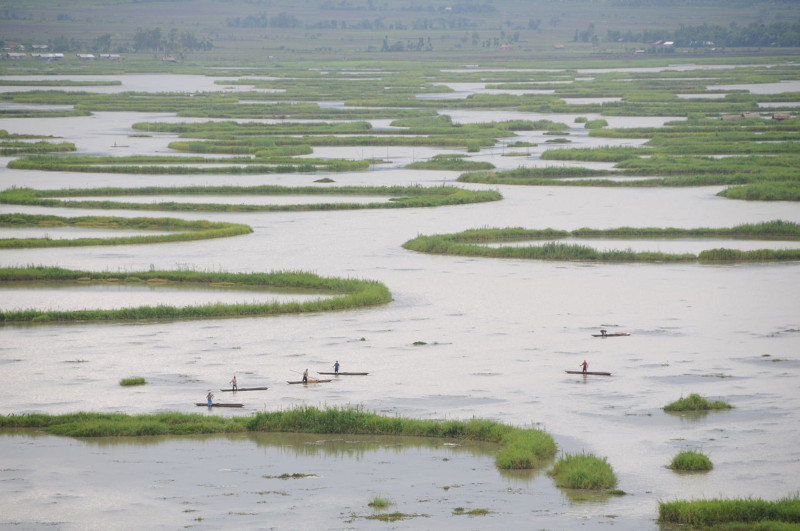
Loktak Lake Facts
- The magnificent body of water known as Loktak Lake constitutes one of those locations that will mesmerize and astound you. That’s because, astoundingly, this truly remarkable lake in fact remains very much unlike other lakes throughout the world.
- It can make this claim, furthermore, for several completely different reasons. Some of these occur quite directly. Others, meanwhile, in an indirect manner. First of all, the marvelous geological feature holds several directly occurring claims to fame.
- For starters, this breathtaking body ranks as the largest known freshwater lake in its particular portion of the globe. It also boasts an incredible array of unique and fascinating, free-floating composite features known as phumdis within its boundaries.
- Indirectly, however, the site also remains important within its region of the world. Due to a naturally occurring combination of location and coincidence, it represents the last known refuge for an endangered animal species known as the Sangai.
- Loktak Lake also forms an important economic function in the region. Many local fisherman rely on it, and it serves as a source of hydroelectric power. Quite fortunately for those who appreciate Nature, efforts to preserve the region remain underway.
- Partly due to the presence of the phumdis, the southeastern section of the lake now forms the Keibul Lamjao National Park. This itself easily distinguishes the location from anywhere else in the world. It’s the only floating national park in the world.
- The coincidental fact that the spot also forms the last known habitat of the Sangai serves as the other reason for the creation of the park. The designation of the area as a park therefore serves an important purpose. It provides the animal with a safe refuge.
Related Articles
Loktak Lake Physical Description
To the surprise of some, the most remarkable thing about Loktak Lake isn’t simply its sheer physical size. This marvel of geology nevertheless does rank as a moderately large freshwater body. This also holds especially true given the area in which it formed.
Understandably, its dimensions naturally vary over its extent, like virtually all lakes. Certain measurements of the impressive body, however, remain possible. For starters, the marvelous geological feature has a maximum measured length of roughly 22 mi (35 km).
The truly amazing location also has a maximum measured width equaling about 8 mi (13 km). These dimensions give the natural wonder an overall roughly oblong shape. The magnificent site also has a total surface area measuring roughly 111 sq mi (287 sq km).
The wonderful Loktak Lake, for all its incredible splendor, may surprise you with yet another physical characteristic, however. That’s the measured depth of its waters. That’s because, for a lake of its other dimensions, one stands out as hard to believe.
This bold statement holds true, nonetheless. The fact holds true due to the fact that its maximum measured depth of reaches a mere 15.1 ft (4.6 m). The average depth of the unique body only equals a meager 8.9 ft (2.7 m). Nature truly loves to astonish us with its variety.
Loktak Lake Location, Formation, and Ecology
The fabulous location of the exotic marvel of Nature called Loktak Lake may come as no surprise to some of you. That’s because the natural wonder formed in a region already filled with countless other wonders of the natural world. It therefore fits perfectly.
That’s due to the fact that it lies in the region now known as the country of India, in Asia. More specifically, it formed in the northeastern part of the land. In addition to everything else, this site owes its formation to the actions of not one, but two local rivers.
These sources bear the local names of the Barak River and the Manipur River. Much like the lake itself, these further have a gentle slope, and often meander through their flow patterns. The site also has a highly convoluted drainage system, much like the roots of a tree.
The area in which Loktak Lake formed has a monsoon climate, and receives copious amounts of rainfall. As a result, it boasts an impressive array of plant life adapted to living in water. In fact, its biological diversity includes a total of 233 known species of aquatic plants.
Doubtless the remarkable phumdis, floating islands made of soil, plants, and organic matter, remain the best known, however. But, the remarkable list of life the area does not stop there. Many avians thrive here. In fact, a total of 57 types of waterbirds live around it.
Along with these, 28 varieties of migrating waterfowl, and 14 species wetland birds also appear. A total of 249 known species of vertebrates, and 176 types of invertebrates also inhabit the surrounding terrain. The best known of these remains the Endangered Sangai.
Species Sharing Its Region
Check out our other articles on 5 Stunning Asian Lepidoptera, Thresher Shark, Pewits Nest, Tree Kangaroo, Christmas Cheer, Brazilian Wandering Spider, Fire Salamander, Texas Horned Lizard
